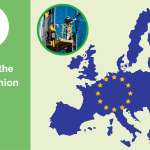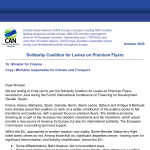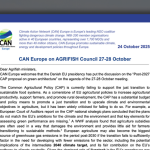Read the CAN Europe Polition Paper on the “Vision for Agriculture and Food” in full here
Executive Summary
In CAN Europe’s view, the European agriculture and food systems should move towards a comprehensive just agroecological transition while constructively contributing to achieving ambitious climate targets in a manner that is fair to farmers, rural communities, consumers and the public at large. The agricultural and food sector in the EU faces significant challenges in the face of its contributions as well as its exposure to rising levels of climate change and extreme weather events, soil degradation, water scarcity, and biodiversity collapse, while there is a need to increase biodiversity protection and nature restoration. Likewise, millions of farmers are confronted with rising production costs and often low farmgate prices, bureaucracy, and exploitation from deep-set incumbents in agriculture and food systems. Cost increases for food in combination with quality of food and sustainability considerations are among the major concerns in the cost of living challenges millions of consumers face.
Transitioning to agroecology, coupled with measures to support farmers and consumers, can alleviate many of these concerns and can show that our agri-food systems can also be a critical part of the solution to climate mitigation and adaptation. Agroecology integrates ecological principles into agricultural systems, promoting biodiversity, improving soil health, reducing peatland emissions, restoring nature, and reducing the need for polluting chemical inputs (and the cost for farmers), and needs to be promoted in a more landscape approach beyond the production at the farm level.
Against this backdrop, CAN Europe highlights the following aspects as critical for the further development and regulatory initiatives for the EU’s agriculture and food systems:
1. There is the need for a binding and ambitious sectoral gross non-CO2 emission reduction target, separate from the LULUCF sector, so that the EU agri-food sector contributes its share to emission reductions, to be developed in the context of the post-2030 climate targets.
2. Move to a policy framework that ensures emission reductions across the food chain as an all-actor task, including by implementing supporting policies including through:
- Revising the Public Procurement directive,
- Addressing and reducing food waste,
- Developing an EU Action Plan for Plant-based Foods.
3. With industrial livestock production being the main cause of EU agriculture emissions, a strategy is needed for the just transition to a more resilient and sustainable EU livestock sector through a territorial approach (incl. quantitative, differentiated reductions of livestock in the context of wider sustainability considerations leading to an overall reduction of livestock numbers);
4. Reform the Common Agricultural Policy (CAP) to support the just transition to sustainable food systems including through:
- A dedicated funding mechanism should support the agri-food just transition;
- Phasing out harmful subsidies, including those that encourage the production and consumption of animal products and area-based direct payments, which are linked to the size of the farm rather than the sustainability of practices;
- Reform income support to be more targeted to those farmers and communities most in need;
- Incentivising sustainable practices and supporting the transition to agroecology.
5. Ensure fair prices for farmers and consumers in a socially-just way by addressing unfair trading practices and making the sustainable, less emission-intense choice the easy one for consumers, like encouraging Member States to differentiate VAT (e.g. plant-based, organic, locally sourced products at 0% VAT; unhealthy, less sustainable food at highest VAT).
6. We support the application of the polluter pays principle in the agriculture sector in the EU. Therefore, options for socially-just carbon pricing should also be considered within a wider policy-mix, while practices that have a positive impact on climate and the environment are rewarded.
7. Ensure consistency between trade policy and sustainability requirements: Achieving this will require the EU to rethink its approach to market access for exports and imports, considering the positive and negative externalities of agri-food trade on environmental sustainability, the competitiveness of EU producers, animal welfare, labour standards, and consumer factors such as price and choice.
Overall, the Vision for Agriculture and Food released on 19 February falls short of these key asks. Positively, its narrative aims to better bring together food production and climate aspects and provides a number of entry points to advance in the direction of CAN Europe’s asks. However, in several ways it stays either very vague or projects key political steps to be outlined in forthcoming strategies and legislative initiatives. It aims to shift agriculture policy even more from conditions to incentives, but without any clarity on whether incentives will be made available at a scale and in a way that they are consistent with critical sustainability and climate objectives. This makes it very difficult to judge how ambitious and comprehensive some of the indicated shifts may become. Overall, it does not sufficiently reflect a transformation away from business-as-usual compatible with the challenges and threats that the climate crisis imposes on the sector. Thus, changes are needed to move towards a comprehensive just agroecological food system transition while constructively contributing to achieving ambitious climate targets and biodiversity goals in a manner that is fair to farmers, rural communities, consumers and the public at large.



